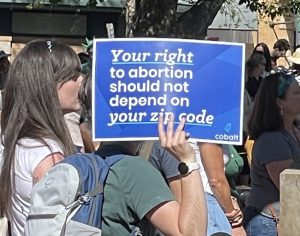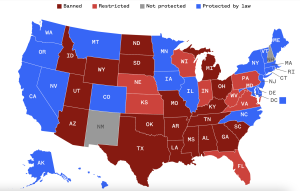

Pictured above: People marching in Boulder, Colorado for Reproductive Health Rights in May of 2022 with signs that say “Your right to abortion should not depend on your zip code.”
Unfortunately, though, zip codes shaping access to abortions may very much be more of a reality with the overturning of Roe v. Wade.
The New York Times reveals how the Supreme Court’s ruling on the Mississippi law could weaken or even overturn Roe v. Wade which could ultimately lead to legal abortion access dramatically decreasing, particularly in the American South and Midwest (Bui et al., 2021). This geographic discrepancy is even more reinforced through social class differences and communities that are “disproportionately Black, Latina, teenagers, uninsured, and undocumented immigrants” (Miller & Sanger-Katz, 2022). Ultimately, leading not only to be a social justice issue and human rights issue, but also a racial justice issue. Bui et al. quotes Caitlin Knowles Myers saying, “A post Roe-United States isn’t one in which abortion isn’t legal at all… it’s one in which there’s tremendous inequality in abortion access.” (Bui et al., 2021).
What bills were recently signed around the country with regards to abortion before the overturning?
Oklahoma
On May 25th, 2022, Oklahoma’s Governor, Kevin Stitt, signed House Bill 4327 which is currently the most restrictive abortion ban in the country banning abortions at the start of fertilization, with very few exceptions (Branham & Forman, 2022).
Florida
Effective July 1, Florida’s Governor, Ron DeSantis, signed a new Florida law, House Bill 5, that bans most of abortions after 15 weeks. This law does not even allow for exceptions of human trafficking, incest, or rape. There would be limited exceptions if the life of the pregnant mother was at risk or if two doctors sign off saying that the baby would die shortly after birth.
Idaho
The Idaho Legislature passed Senate Bill 1385 in 2020 which would take effect only 30 days after overturning of the U.S. Supreme Court Roe v. Wade. This trigger law would treat performing an abortion or even attempting to perform an abortion as a felony that could be punishable with a minimum of two year prison sentence. This law will have limited exceptions for rape and incest, but these must have official documentation.
Kentucky
Kentucky passed House Bill 3 to restrict abortion access; however, U.S. District Judge Rebecca Grady Jennings issued a temporary order block.
Texas
Governor Greg Abbott of Texas passed a restrictive law on September 1st, 2021, SB 8, which prevented abortions after 6 weeks, a period of time that many women are not even sure that they are pregnant yet.
REINFORCING ABORTION:
New York
On June 1st, the State of New York has protected abortion access through the legislators passing a series of bills to strengthen abortion access. The 6 bills have already passed the state senate and wait the signature of the governor. They include: Bill S.9079A which prohibits Medical Misconduct Charges for Performing Reproductive Health Care and Bill S.9039A which offers freedom from Interferences with Reproductive eHealth Advocacy and Travel Exercise. Additionally, New York set aside at least $35 million fund for State Abortion Providers.
What did pre-Roe look like around the country?
Before Roe v. Wade in 1973, abortion was available in four states (Alaksa, Hawaii, New York, and Washington) and 13 other states allowed abortions for health reasons (Miler & Sanger-Katz, 2022). Women with the financial resources, could travel out of state for the procedure; however, it was incredibly dim time with women turning to “coat-hangers, chemicals, unskilled abortion providers, and other dangerous methods” (Miler & Sanger-Katz, 2022). In fact, Cook County Hospital in Chicago treated over 4,000 women each year in early 1960s due to life-threatening complications of these unsafe abortions.
Where are we currently headed across the country?
Caitlin Myers, an economist at Middlebury, calculated that for women living in sates that ban abortion, the average distance to seek the nearest provider would increase from 282 miles from about 33 miles now (Miller & Sanger-Katz, 2022). These distances would vary based on state, preventing some women from even getting these resources.
Gutmmacher Institute offers an interactive map with how a total ban on abortion would increase the average driving distance for someone living in each state to seek the nearest provider. They calculate the average distance of travel to a provider would increase from an abortion clinic being an average of 17 miles away under legal status in Texas all the way to 542 miles under a total ban (Guttmacher Institute, 2021). Louisiana increases from an average of 37 miles to travel up to 666 miles under a total ban with 59% of those women having to travel up to Illinois for care (Guttmacher Institute, 2021).
Abortion pill future
The Washington Post reflects upon the implications of abortion pills by mail which can be used safely at home to effectively terminate pregnancy up to 10 weeks (Miller & Sanger-Katz, 2022). Especially with the dependency during the Covid-19 Pandemic with communications of providers virtually, how will this impact the accessibility to the pills?
Plan C was a website created to link people to five different online pharmacies in India and they saw over 56,000 online visitors on their website the day after the leaked draft Supreme Court ruling (Rowland et al., 2022). Rowland et al. (2022) reflect on if the FDA could change the sale of both mifepristone and misoprostol to be over the counter instead of prescription; however, drug safety experts see this as unlikely and the banned states would still restrict access to the medications.
NBC News- Abortion in a Post-Roe World
Resources to check out:
Advocacy Resources Provided by the Duke Obstetrics and Gynecology Website:
- Contact your legislators. Use this link in NC and type in your address to find the names and links to contact information for your NC Senator and House Representative
- Check out these talking points about abortion from the American College of Obstetricians and Gynecologists
- Other Advocacy resources to learn about the importance of abortion access
- Donate to local abortion funds
- Carolina Abortion Fund
- Funding to pay for procedures for patients in NC and SC with a need for financial support
- Duke Abortion Fund
- Internal fund for patients who need financial support seeking care at Duke
- Carolina Abortion Fund
TO LEARN MORE:
Articles:
- The Atlantic, Predictions for a Post-Roe America
- NPR, Here’s what could happen if Roe v. Wade is overturned
- Guttmacher Institute, If Roe v. Wade is Overturned: New Interactive Map Shows How Far People Seeking Abortion in the 26 States Certain or Likely to Ban the Procedure Will Need to Travel to Get the Care They Need
- CNBC, If Supreme Court reverses Roe v. Wade, up to half of U.S. expected to ban or severely restrict abortion
- The New York Times, Where Abortion Access Would Decline if Roe v. Wade Were Overturned
- The New York Times, What an America Without Roe Would Look Like
- MedicalNewsToday, Explaining leaked Roe v. Wade opinion: What could happen next?
- NBC News, Map: 23 States would ban abortion in a post-Roe America
- Duke University; Video How SCOTUS Abortion Decision will Impact Women’s Health- Media Briefing
Podcasts:
- Banned, WWNO
- EP 1 → The Law
- EP 2 → The Pink House
- EP 3 → The Providers
- The Daily
- The Ezra Klein Show
- ACCESS: A Podcast About Abortion
References
Berman, R. (2022, May 5). Explaining leaked Roe v. Wade opinion: What could happen next? MedicalNewsToday. https://www.medicalnewstoday.com/articles/explaining-leaked-roe-v-wade-opinion-what-could-happen-next
Branham, D. & Forman, C. (2022, May 25). What we know about Oklahoma’s new abortion ban- the strictest in the nation. The Oklahoman. https://www.oklahoman.com/story/news/2022/05/25/oklahoma-implemented-nations-strictest-abortion-ban-kevin-stitt-republican-texas/9891989002/
Bui, Q., Miller, C, & Sanger-Katz, M. (2021, May 18). Where Abortion Access Would Decline if Roe v. Wade Were Overturned. The New York Times. https://www.nytimes.com/interactive/2021/05/18/upshot/abortion-laws-roe-wade-states.html
Chiwaya, N. & Da Silva, C. (2022, May 3). Map: 23 States would ban abortion in a Post-Roe America. NBC News. https://www.nbcnews.com/data-graphics/map-23-states-ban-abortion-post-roe-america-rcna27081
Corbin, C. (2022, May 13). Idaho’s abortion trigger law would take effect 30 days after Roe v. Wade is Overturned. Idaho Capital Sun. https://idahocapitalsun.com/2022/05/13/idahos-abortion-trigger-law-would-take-effect-30-days-after-roe-v-wade-is-overturned/
Guttmacher Institute. (2021, October 28). If Roe v. Wade is Overturned: New Interactive Map Shows How Far People Seeking Abortion in the 26 States Certain or Likely to Ban the Procedure Will Need to Travel to Get the Care They Need. Guttmacher Institute. https://www.guttmacher.org/news-release/2021/if-roe-v-wade-overturned-new-interactive-map-shows-how-far-people-seeking-abortion
Halpert, M. (2022, May 10). New York Launches $35 Million Fund to Help State Abortion Providers. Forbes. https://www.forbes.com/sites/madelinehalpert/2022/05/10/new-york-launches-35-million-fund-to-help-state-abortion-providers/?sh=8cadc4c1fe47
Hernandez, J. (2022, May 3). Here’s what could happen if Roe v. Wade is overturned. NPR. https://www.npr.org/2022/05/03/1096094942/roe-wade-overturned-what-happens-next
Kaplan, A. (2022, June 1). NYS legislators pass bills strengthening abortion access. The New York State Senate. https://www.nysenate.gov/newsroom/in-the-news/anna-m-kaplan/nys-legislators-pass-bills-strengthening-abortion-access
Mangan, D. (2022, May 3). If Supreme Court reverses Roe v. Wade, up to half of U.S. expected to ban or severely restrict abortion. CNBC. https://www.cnbc.com/2022/05/03/supreme-court-ruling-undoing-roe-abortion-case-would-spark-state-bans.html
Miller, C., & Sanger-Katz, M. (2022, May 4). What an America Without Roe Would Look Like. The New York Times. https://www.nytimes.com/2021/12/05/upshot/abortion-without-roe-wade.html
NPR. (2022, April 14). Florida Gov. Ron DeSantis signs a bill banning abortions after 15 weeks. NPR. https://www.npr.org/2022/04/14/1084485963/florida-abortion-law-15-weeks
Rowland, C., McGinley, L., & Bogage, J. (2022, May 4). Abortion pills by mail pose challenge for officials in red states. The Washington Post. https://www.washingtonpost.com/business/2022/05/04/abortion-pills-online-telemedicine/
Yetter, D. (2022, April 21). Judge puts temporary hold on Kentucky abortion law, clearing way for services to resume. Louisville Courier Journal. https://www.courier-journal.com/story/news/politics/ky-general-assembly/2022/04/21/judge-temporarily-blocks-2022-kentucky-abortion-law/7318975001/

